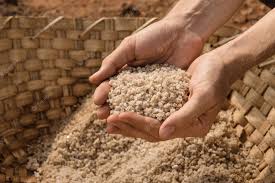Years ago, Karnataka villager Venkat Nayak used to curse the saline water gushing into his fields from the Arabian Sea. He was unable to farm his one-acre plot on the banks of the Aghanashini river which passes by Sanikatta village near Gokarna. And then he decided to follow an old practice, which revived the fortunes of farmers like him. He decided to turn the unusable water to his advantage. And struck salt.
Since 1720, the brown salt business has operated in Sanikatta, one of the oldest places engaged in this business in the country. However, it became an organised sector only after the cooperative society was formed. The extraction of salt is done by the villagers, who work in pans spread over 564 acres on the bank of the Aghanashini. While they would market it individually earlier, they came together in 1952 to form the cooperative society. Since then, they have been making 10,000-12,000 metric tonnes of salt every year, which is sold mainly to Ayurveda and naturopathy centres, direct customers at the production unit, and e-commerce platforms.
Sanikatta salt is a natural salt extracted from the water that flows into the Aghanashini basin. As soon as the rainy season ends, the water is taken from the basin and stored in a large reservoir for some days where it is allowed to evaporate naturally and increase in density. This process begins sometime in November. When the density reaches 2.5 degrees, the water is let into about 400 acres of salt fields.
“We produce salt from the Aghanashini river water using a natural process, which is why its colour is brown,” says Arun Nadakarni, chairman of Nagarbail Salt Owners Cooperative Society. “This salt is a medicinal product, containing nearly 96 per cent minerals, with 4 per cent of them being rare minerals.
This is because leaves, stems, and plants, some of which are medicinal, that fall into the Aghanashini river during the course of the year get accumulated in the basin and the natural ingredients of these medicinal plants get dissolved in the water.

